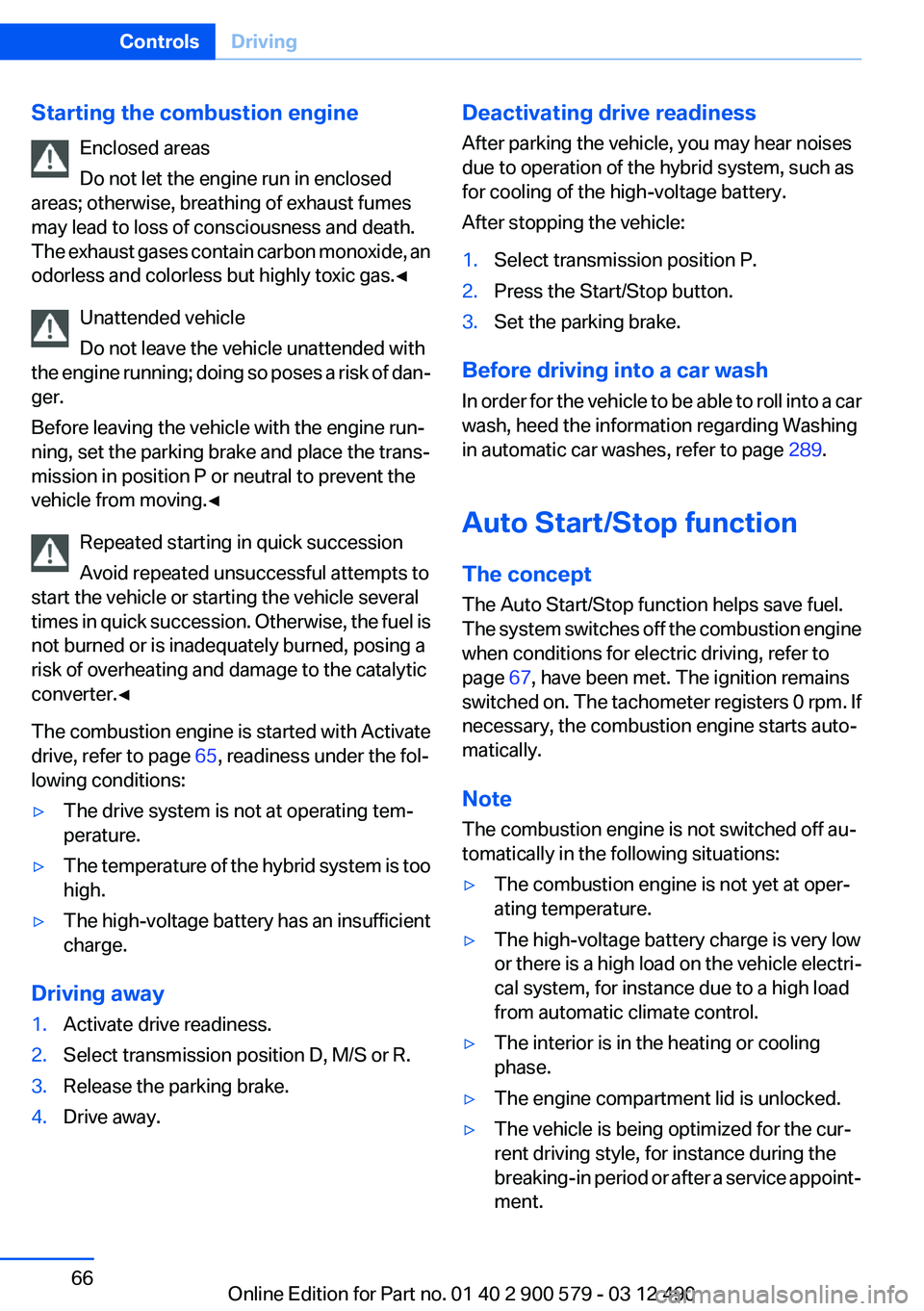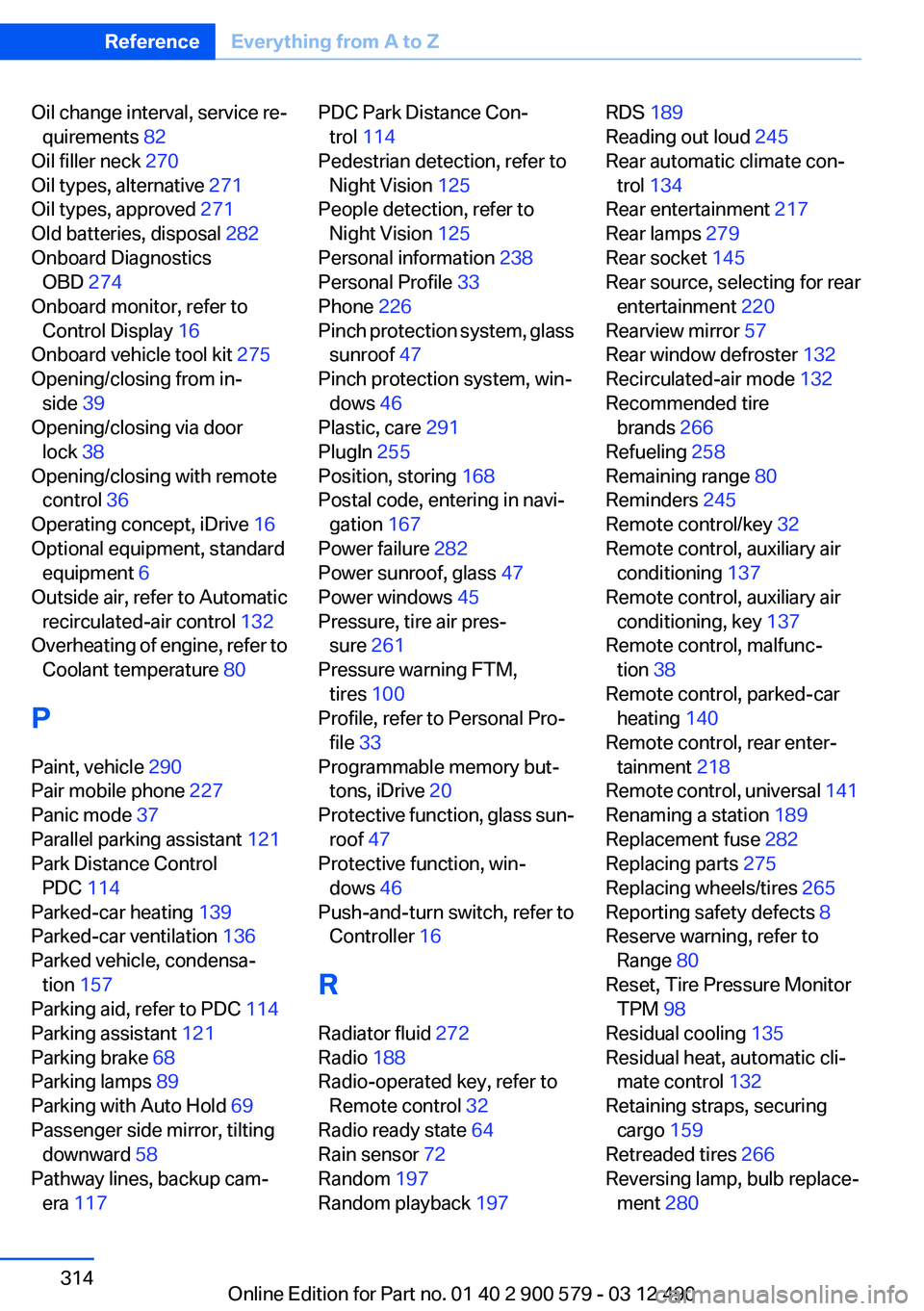overheating BMW ACTIVEHYBRID 5 2012 Owners Manual
[x] Cancel search | Manufacturer: BMW, Model Year: 2012, Model line: ACTIVEHYBRID 5, Model: BMW ACTIVEHYBRID 5 2012Pages: 319, PDF Size: 12.54 MB
Page 66 of 319

Starting the combustion engineEnclosed areas
Do not let the engine run in enclosed
areas; otherwise, breathing of exhaust fumes
may lead to loss of consciousness and death.
The exhaust gases contain carbon monoxide, an
odorless and colorless but highly toxic gas.◀
Unattended vehicle
Do not leave the vehicle unattended with
the engine running; doing so poses a risk of dan‐
ger.
Before leaving the vehicle with the engine run‐
ning, set the parking brake and place the trans‐
mission in position P or neutral to prevent the
vehicle from moving.◀
Repeated starting in quick succession
Avoid repeated unsuccessful attempts to
start the vehicle or starting the vehicle several
times in quick succession. Otherwise, the fuel is
not burned or is inadequately burned, posing a
risk of overheating and damage to the catalytic
converter.◀
The combustion engine is started with Activate
drive, refer to page 65, readiness under the fol‐
lowing conditions:▷The drive system is not at operating tem‐
perature.▷The temperature of the hybrid system is too
high.▷The high-voltage battery has an insufficient
charge.
Driving away
1.Activate drive readiness.2.Select transmission position D, M/S or R.3.Release the parking brake.4.Drive away.Deactivating drive readiness
After parking the vehicle, you may hear noises
due to operation of the hybrid system, such as
for cooling of the high-voltage battery.
After stopping the vehicle:1.Select transmission position P.2.Press the Start/Stop button.3.Set the parking brake.
Before driving into a car wash
In order for the vehicle to be able to roll into a car
wash, heed the information regarding Washing
in automatic car washes, refer to page 289.
Auto Start/Stop function
The concept
The Auto Start/Stop function helps save fuel.
The system switches off the combustion engine
when conditions for electric driving, refer to
page 67, have been met. The ignition remains
switched on. The tachometer registers 0 rpm. If
necessary, the combustion engine starts auto‐
matically.
Note
The combustion engine is not switched off au‐
tomatically in the following situations:
▷The combustion engine is not yet at oper‐
ating temperature.▷The high-voltage battery charge is very low
or there is a high load on the vehicle electri‐
cal system, for instance due to a high load
from automatic climate control.▷The interior is in the heating or cooling
phase.▷The engine compartment lid is unlocked.▷The vehicle is being optimized for the cur‐
rent driving style, for instance during the
breaking-in period or after a service appoint‐
ment.Seite 66ControlsDriving66
Online Edition for Part no. 01 40 2 900 579 - 03 12 490
Page 158 of 319

LoadingVehicle equipment
All standard, country-specific and optional
equipment that is offered in the model series is
described in this chapter. Therefore, equipment
is also described that is not available in a vehicle,
e. g., because of the selected optional equip‐
ment or country variant. This also applies for
safety-related functions and systems.
General information Overloading the vehicle
To avoid exceeding the approved carrying
capacity of the tires, never overload the vehicle.
Overloading can lead to overheating and in‐
creases the rate at which damage develops in‐
side the tires. This could result in a sudden loss
of tire inflation pressure.◀
No fluids in the trunk
Make sure that fluids do not leak into the
trunk; otherwise, the vehicle may be damaged. ◀
Determining the load limit1.Locate the following statement on your ve‐
hicle’s placard:▷The combined weight of occupants and
cargo should never exceed XXX kg or
YYY lbs. Otherwise, damage to the ve‐hicle and unstable driving situations may
result.2.Determine the combined weight of the
driver and passengers that will be riding in
your vehicle.3.Subtract the combined weight of the driver
and passengers from XXX kilograms or YYY
pounds.4.The resulting figure equals the available
amount of cargo and luggage load capacity.
For example, if the YYY amount equals
1,000 lbs and there will be four 150 lbs pas‐
sengers in your vehicle, the amount of avail‐
able cargo and luggage load capacity is
400 lbs: 1,000 lbs minus 600 lbs = 400 lbs.5.Determine the combined weight of luggage
and cargo being loaded on the vehicle. That
weight may not safely exceed the available
cargo and luggage load capacity calculated
in Step 4.
Load
The maximum load is the sum of the weight of
the occupants and the cargo.
The greater the weight of the occupants, the
less cargo that can be transported.
Seite 158Driving tipsLoading158
Online Edition for Part no. 01 40 2 900 579 - 03 12 490
Page 314 of 319

Oil change interval, service re‐quirements 82
Oil filler neck 270
Oil types, alternative 271
Oil types, approved 271
Old batteries, disposal 282
Onboard Diagnostics OBD 274
Onboard monitor, refer to Control Display 16
Onboard vehicle tool kit 275
Opening/closing from in‐ side 39
Opening/closing via door lock 38
Opening/closing with remote control 36
Operating concept, iDrive 16
Optional equipment, standard equipment 6
Outside air, refer to Automatic recirculated-air control 132
Overheating of engine, refer to Coolant temperature 80
P
Paint, vehicle 290
Pair mobile phone 227
Panic mode 37
Parallel parking assistant 121
Park Distance Control PDC 114
Parked-car heating 139
Parked-car ventilation 136
Parked vehicle, condensa‐ tion 157
Parking aid, refer to PDC 114
Parking assistant 121
Parking brake 68
Parking lamps 89
Parking with Auto Hold 69
Passenger side mirror, tilting downward 58
Pathway lines, backup cam‐ era 117 PDC Park Distance Con‐
trol 114
Pedestrian detection, refer to Night Vision 125
People detection, refer to Night Vision 125
Personal information 238
Personal Profile 33
Phone 226
Pinch protection system, glass sunroof 47
Pinch protection system, win‐ dows 46
Plastic, care 291
PlugIn 255
Position, storing 168
Postal code, entering in navi‐ gation 167
Power failure 282
Power sunroof, glass 47
Power windows 45
Pressure, tire air pres‐ sure 261
Pressure warning FTM, tires 100
Profile, refer to Personal Pro‐ file 33
Programmable memory but‐ tons, iDrive 20
Protective function, glass sun‐ roof 47
Protective function, win‐ dows 46
Push-and-turn switch, refer to Controller 16
R
Radiator fluid 272
Radio 188
Radio-operated key, refer to Remote control 32
Radio ready state 64
Rain sensor 72
Random 197
Random playback 197 RDS 189
Reading out loud 245
Rear automatic climate con‐ trol 134
Rear entertainment 217
Rear lamps 279
Rear socket 145
Rear source, selecting for rear entertainment 220
Rearview mirror 57
Rear window defroster 132
Recirculated-air mode 132
Recommended tire brands 266
Refueling 258
Remaining range 80
Reminders 245
Remote control/key 32
Remote control, auxiliary air conditioning 137
Remote control, auxiliary air conditioning, key 137
Remote control, malfunc‐ tion 38
Remote control, parked-car heating 140
Remote control, rear enter‐ tainment 218
Remote control, universal 141
Renaming a station 189
Replacement fuse 282
Replacing parts 275
Replacing wheels/tires 265
Reporting safety defects 8
Reserve warning, refer to Range 80
Reset, Tire Pressure Monitor TPM 98
Residual cooling 135
Residual heat, automatic cli‐ mate control 132
Retaining straps, securing cargo 159
Retreaded tires 266
Reversing lamp, bulb replace‐ ment 280 Seite 314ReferenceEverything from A to Z314
Online Edition for Part no. 01 40 2 900 579 - 03 12 490